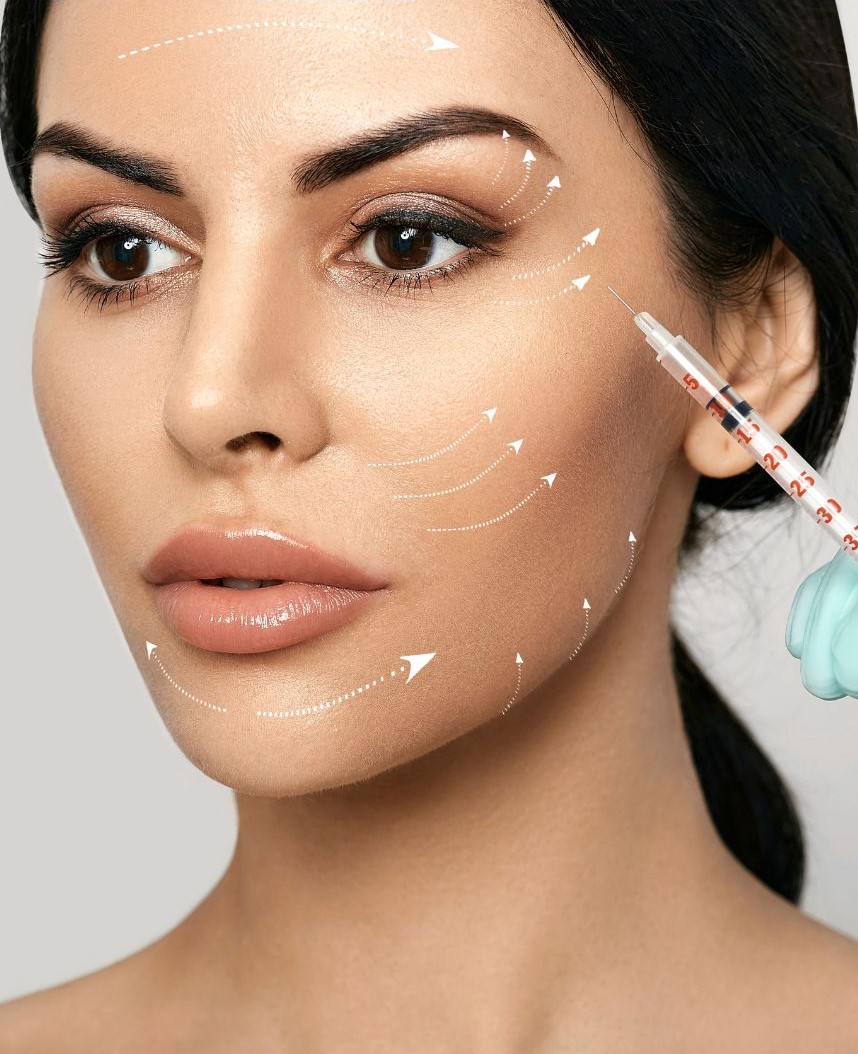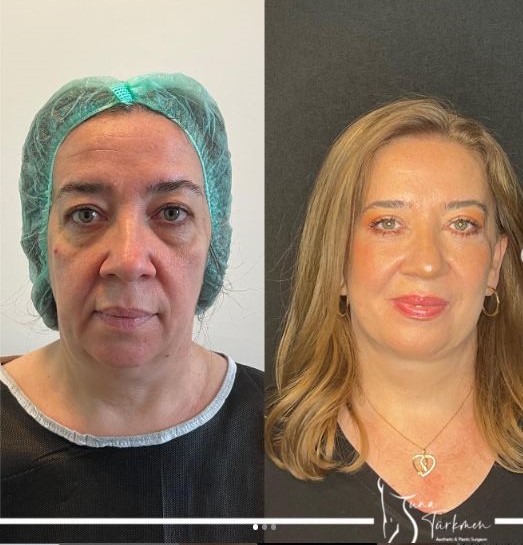What are the techniques of face lift?

During the process, the skin and subcutaneous tissues covering the face bones are treated. During the liposuction procedure, fat from the neck is also suctioned out. The skin-level incision is followed by the subcutaneous tissue. The layer that supports the skin and subcutaneous tissues is severed. The subcutaneous tissues that were removed are restored to their original positions. After the tissues have been healed, the facial skin is put over them, the hairline is straightened, and any excess skin is cut off. The areas that have been sliced are closed with wire or surgical sutures.
A vacuum drain is placed to keep blood from accumulating in the working area. After the operation, the face is wrapped using an easy-to-use face wrap. This wrap is frequently replaced with an elastic bandage the day after the treatment. The patient gets released either the day of the procedure or the day following it. Depending on the type of treatment, the size of the surgical site, and whether additional applications are made, the procedure could take anywhere from two to six hours to complete.

In order to perform an endoscopic facial lift, tiny incisions are made in the scalp area, and the upper and middle faces are lifted using an endoscope. Occasionally, an additional incision may be made via the mouth. When the events are happening, the entire area may be seen via the camera. The endoscopic method treats wrinkles that are not very noticeable. Using a number of methods, the bones are identified again after the cheeks, forehead, and area surrounding the eyes are moved forward from the bone membrane in this process. This approach has several benefits, including long-term effects and the unpredictable nature of the incision marks from the outside. Its use has no beneficial effects on the neck or lower facial area. This technique may be used in conjunction with neck lift and lower face lift procedures in specific circumstances. Under general anesthesia, endoscopic face lift operations take one to two hours to complete in the operating room. Complications following surgery, such as bleeding, infection, and discomfort, are rarely documented.
The natural line areas in front and behind the ears are where the incisions for a typical face lift are performed. Since the incision is made in areas like the scalp, front, and back of the ear, there might not be much of a face scar. This face scar eventually fades and becomes the same color as the skin after seven days. On the other hand, postoperative care is essential. Continued use of alcohol or cigarettes may exacerbate the healing process and make the scarring more noticeable.
Compared to a standard facial lift, a micro-face lift involves smaller skin incisions. Due to its small size, wounds heal more quickly and leave fewer scars. This technique involves tugging and stretching the area around the chin and cheekbones. The outcomes of the procedure are not as obvious as they would be in a conventional setting. Skin that is less sagging or wrinkled is a good candidate for the little face lift surgery. Incisions are created along the ear in the natural creases of the skin, from just below the temples to the hairline. The surgery is usually performed under general anaesthesia.
This technique concentrates on the middle portion of the face, including the cheeks and lower eyelids. It helps address issues such as sagging cheeks and hollowing under the eyes by lifting and repositioning underlying tissue.
A thread face lift can be used to stretch out mild cases of facial sagging without requiring surgery. In order to hide it from view beneath the skin, the rope is draped over the drooping area. A younger, more refined, brighter, and more taut-looking facial image is the outcome of this surgery. The permanence of melting threads lasts 1-2 years; permanent threads, on the other hand, last 5-7 years because they are not absorbed by the body. Because of the placement of the connections on the ropes, there is almost minimal possibility of them breaking. This procedure may help patients with severe skin sagging. The conventional method works best in cases with significant drooping and well-established deep lines.
A few weeks following the thread-based facelift, collagen bundles form around the thread. Under-skin threads encourage blood flow, the production of collagen, and the hydration of the skin. Increased production of a particular type of protein known as collagen tightens the skin, smooths wrinkles, and gathers sagging skin. The majority of individuals in the 40–50 age range preferred this tactic. People over 50 shouldn't get it done since, as they age, the skin surrounding their chins will droop more.
The non-surgical satin face lift method uses radiofrequency radiation to stimulate the production of collagen in tissues and thicken skin. This energy is applied concurrently to all layers of the skin, speeding up the production of collagen and connective tissue. An increase in connective tissue mediates the improvement of skin wrinkles. There is no pain experienced throughout the procedure.
During the procedure, Positive results may be observed right away with this therapy, which effectively reduces body and facial fat as well as skin drooping. Without requiring surgery, patients of all ages can safely eliminate facial aging. particularly in the regions surrounding the mouth, lips, chin, jawline, and neck décolleté. Most patients receive two to four treatment sessions, separated by fourteen to twenty-eight days. Sessions usually last between fifteen and sixty minutes, depending on the applied region.

It is advised for wrinkles and sagging in the middle of the face, lower eyelid, and cheek. Problems arise more frequently, and the recovery process takes longer.
It involves stretching the fat tissues, subcutaneous muscle, and skin simultaneously as a single structure. Problems that the standard method is unable to resolve, such as the drooping of the cheekbone fat pad and the widening grooves on the side of the nose, can be resolved using this process. It takes longer than normal to recover.
What is the difference between an endoscopic facelift and a traditional facelift?
An endoscopic face lift and a traditional face carry differ in some strategies, which include:
- Incision size and placement
- Tissue repositioning
- Fat removal
- Anesthesia
- Healing time
- Scarring
- Price
An endoscopic face lift uses tiny incisions, commonly less than an inch in length, completed inside the hairline or at the back of the ears in place of an everyday face enhancement, which often includes big incisions made across the hairline and all the way down to the ears.
In an endoscopic face lift, the underlying facial tissues are lifted and repositioned through smaller incisions using specialized gadgets and a small camera, rather than the longer incisions used in desired face lifts.
An endoscopic face lift normally omits this phase, despite the fact that in superb conditions, a general face lift may additionally require eliminating extra fat from the face and neck.
While an endoscopic face lift can be done under neighborhood anesthesia or sedation, a regular face lift is normally carried out under modern-day anesthesia.
A typical endoscopic face-lift healing takes 1-2 weeks, but a general face-lift restoration can take numerous weeks. Most sufferers are able to resume everyday sports after the treatment.
While endoscopic face lift surgical procedures commonly leave few scars, traditional face lift surgical treatments can remove high-quality scars.
Because an endoscopic face lift calls for much less time and a much less invasive surgical procedure than an ordinary face lift, the cost of an endoscopic face lift is commonly a whole lot less than that of the latter.
Ultimately, an affected person's desires and clinical experts’ pointers will decide whether they choose an endoscopic or giant face lift.
What are the benefits of an endoscopic face lift?
Should I choose endoscopic face lift?
Endoscopic face lift treatments frequently lead to less scarring, less edoema, and a shorter recovery time. However, not every patient may benefit from this procedure, and the outcomes might not be as striking as they would be with a complete facelift. You should discuss all of your options with a qualified and experienced cosmetic surgeon in order to choose which procedure is best for you.
Note:
Please contact us for additional information or to schedule a consultation for rib removal with us.
This article is for informational and advisory purposes. The recommendations of your surgeon who will examine you and perform your surgery should be a priority.
